15 Best Things To Do In Aswan (A Local’s Guide)
16 min readWith its picturesque temples, vibrant culture and laid-back atmosphere, Aswan is a must-see on your Egypt itinerary. Here are the best things to do in Aswan.
Aswan is a Nile-side city in southern Egypt known for its colorful Nubian villages, tall felucca sail boats and ornate Graeco-Roman temples.
Aswan is a popular starting (or ending) point of a Nile Cruise, and a great base for a day trip to Abu Simbel. But it’s also a tranquil city that’s unlike anywhere else in Egypt – and a favorite among seasoned travelers for its lively souqs and temple-studded islands.
Aswan was once celebrated for its stone quarries, which supplied colossal statues, obelisks and shrines to monuments throughout Ancient Egypt. Today its known for temples, botanical gardens, friendly locals and chilled-out vibes that make it a refreshing getaway from the city.
Aswan boasts mud-brick homes, river banks hemmed by sand dunes and feluccas gliding over a shimmering river that are every photographer’s dream.
Some interesting facts about Aswan:
- Aswan is the ancient city of Swenett, which marked the southernmost frontier of Ancient Egypt. It was important as a strategic military station and a trading city that linked Egypt to the rest of Africa.
- Modern-day Aswan is a favorite winter destination for locals and expats. The city boasts short and mild winters, and a great selection of resorts from luxury hotels to budget-friendly island guest houses.
- Aswan is called the Land of Gold because it was a crucial urnfield for generations of pharaohs that supplied gold to adorn countless Ancient Egyptian treasures.
So where do you begin to explore this underrated gem along the Nile?
I’m a longtime expat living in Cairo and I’ve visited Aswan numerous times. This is my ultimate local’s guide to this southern city – including practical tips and hidden gems!
Here are the best things to do in Aswan:
1. Explore Philae Temple
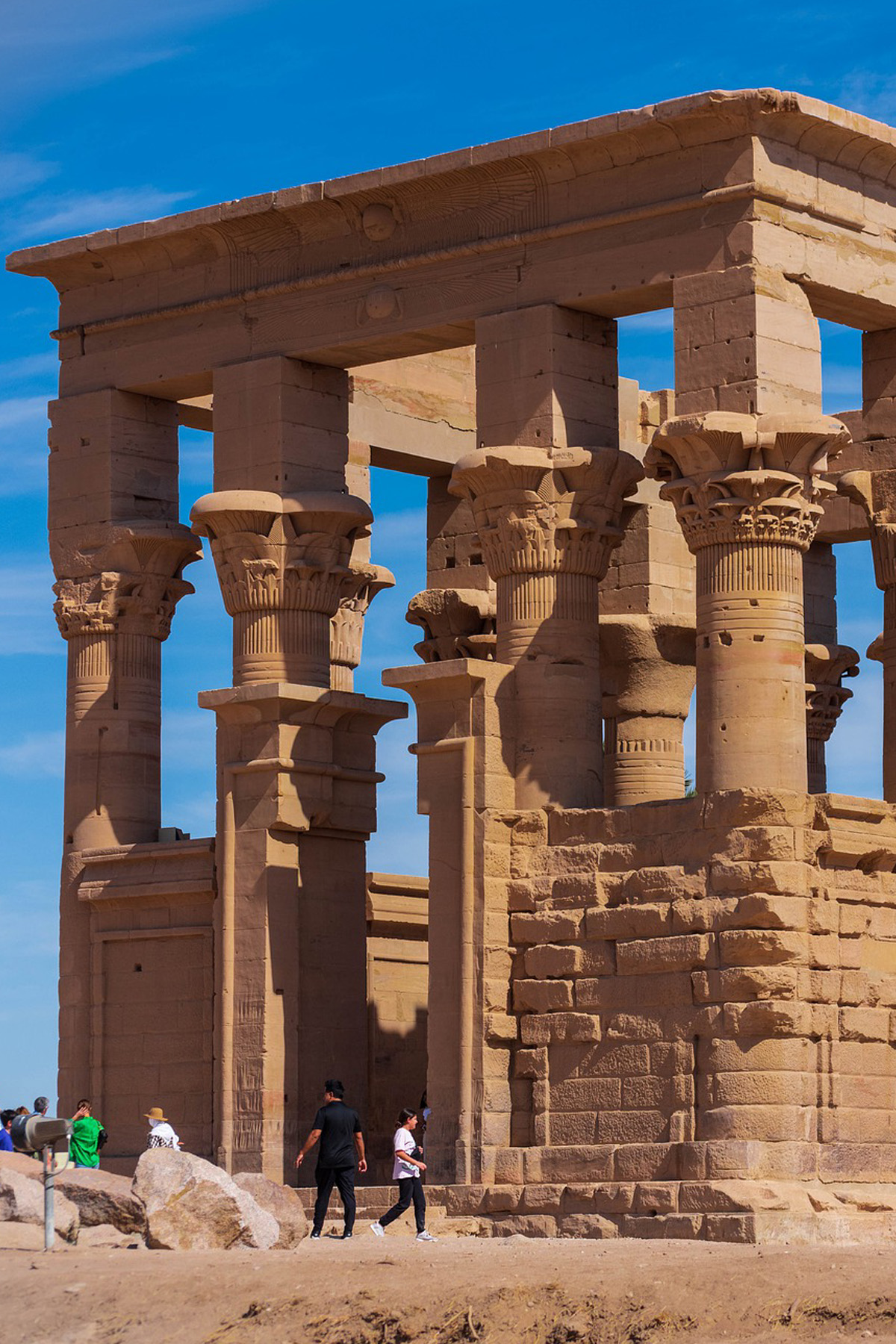

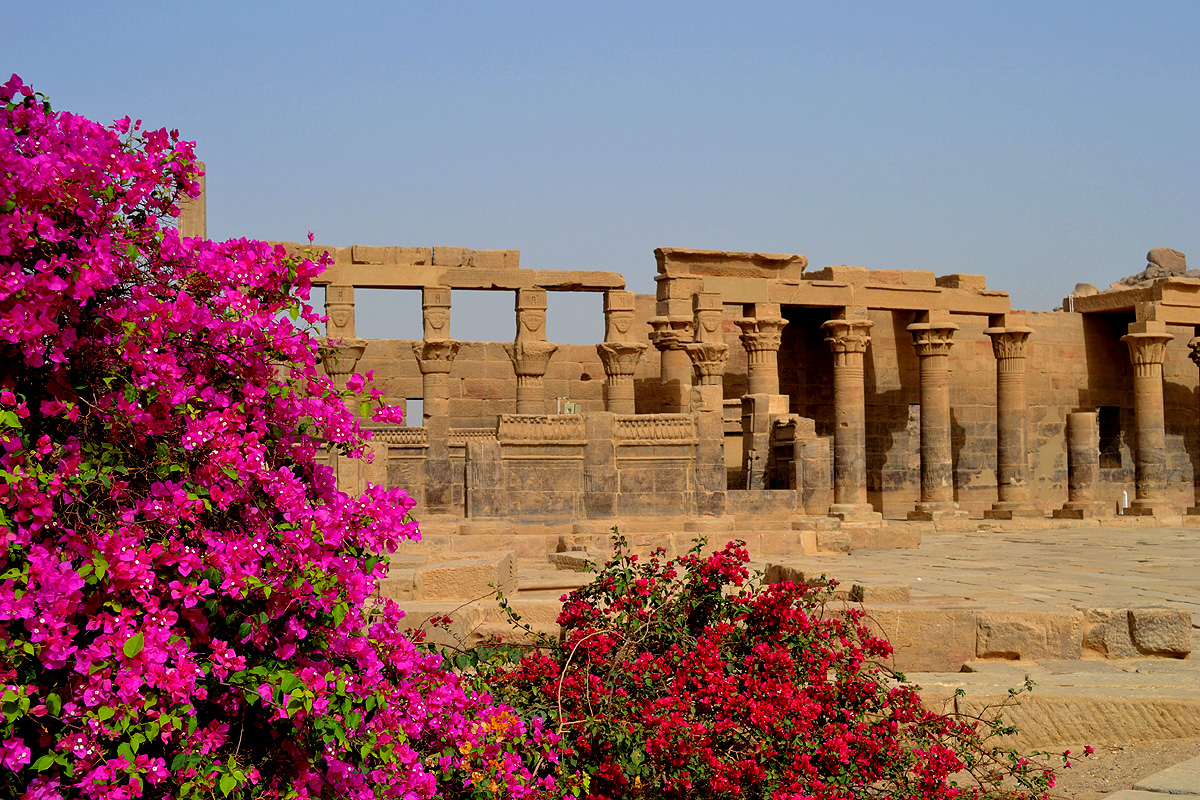

Nestled on a tiny island in the Nile, Philae is one of Egypt’s most romantic temples – and a beautiful tribute to the Egyptian goddess Isis.
Built by the Macedonian king Ptolemy II, the temple was one of the last active Ancient Egyptian temples where the old pagan gods were worshiped. It was also used as a church after Christianity arrived in Egypt – a small alter with a cross can still be seen inside the temple’s hypostyle hall.
Take a boat to this island and explore the columns and last known hieroglyphics that line this architectural gem.
Philae Temple is an absolute must-see on your Aswan itinerary – and definitely the city’s top attraction.
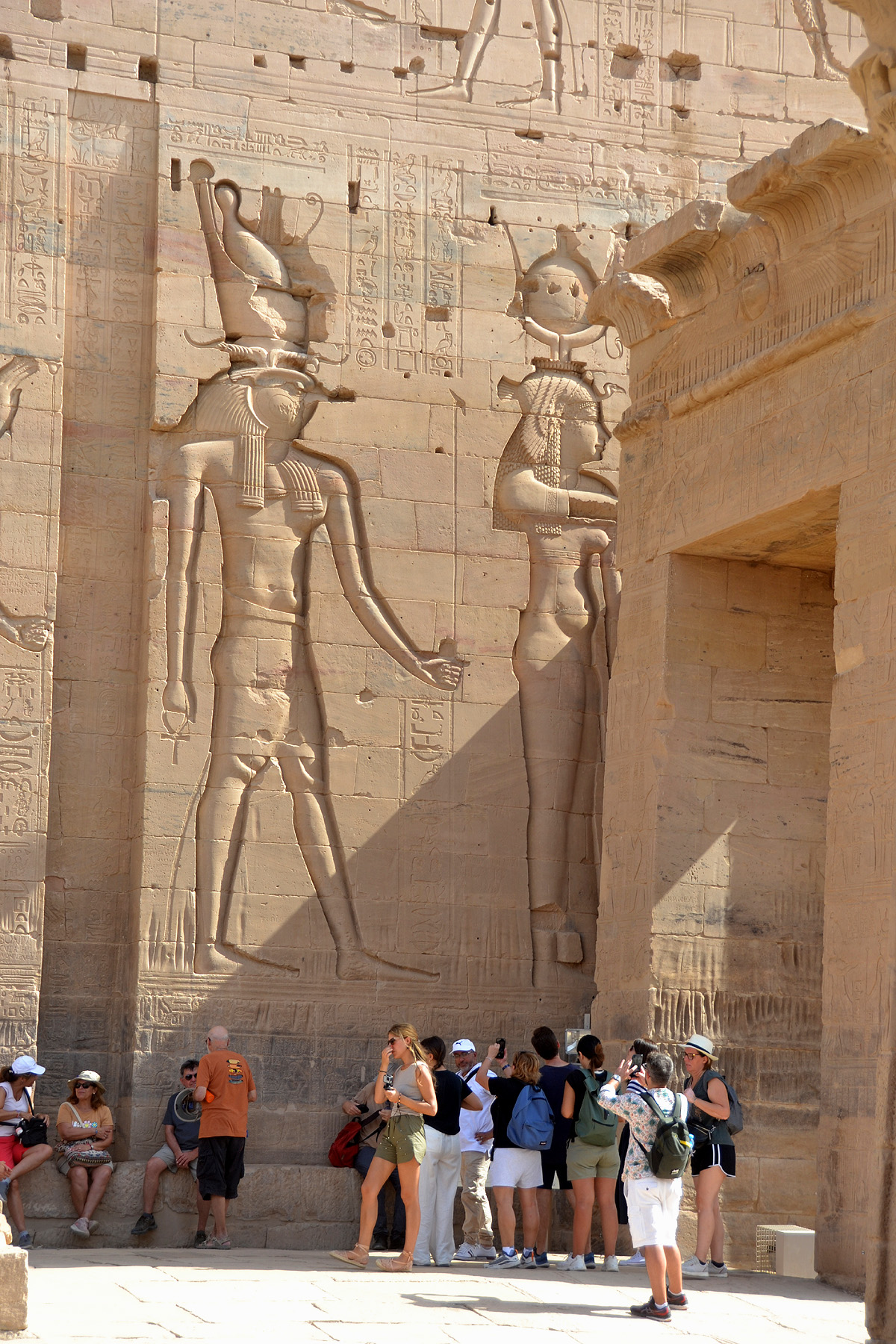

Philae Temple is dedicated to Isis, her husband Osiris and their son Horus. The temple walls depict stories of Isis giving birth to Horus, bringing Osiris back to life and mummifying Osiris’ remains after his death.
The temple also has a miraculous modern-day rescue story.
After the construction of the Aswan Dam, Philae Temple became partly submerged by the rising waters of the Nile. But when the High Dam was built in 1960-71, UNESCO launched an epic scale project to save the ancient temple by relocating it – piece by piece – to the nearby island of Agilkia where it would be save from flooding.
Purchase your ticket at the Philae Temple Marina, then hop on one of the numerous motorboats that take visitors on the 10-minute trip to the island.
2. See the Sound & Light Show
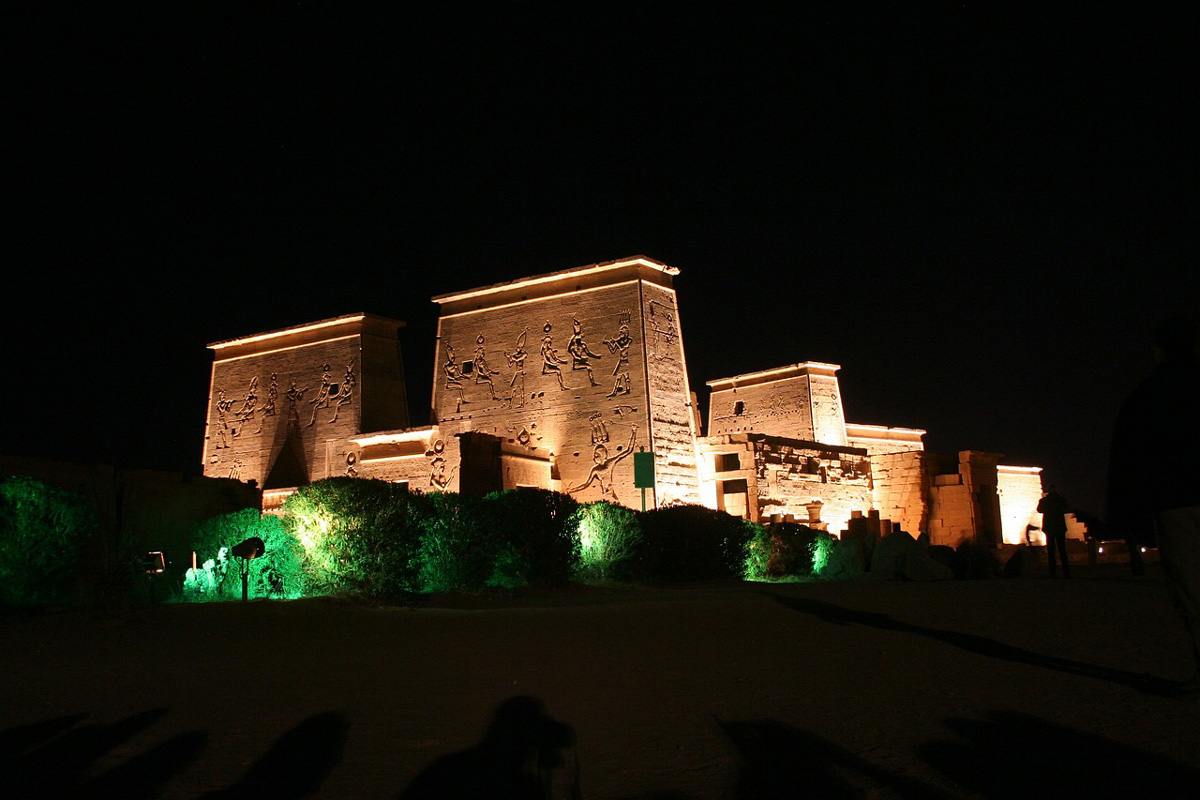

Visit the temple at night for a dazzling sound and light show (20 USD) that brings ancient gods and histories to life.
Held in 10 different languages, with times starting at 7 or 8pm, you can book your tickets online to experience the island under a starry sky.
3. Discover an island hidden gem
Get off the beaten path and explore one of Aswan’s lesser-visited islands to learn about real Nubian life and unwind among rustic landscapes.
Heissa is an old Nubian island about a 20-minute boat ride from Philae Temple – and it offers a refreshing retreat from Aswan’s more touristy Nubian villages. It’s also one of the oldest standing Nubian islands that remained after the floods of the 1960s and the building of the High Dam.
I visited with Egypt Rest Tours and spent an afternoon drinking mint tea, then strolling through brightly painted Nubian homes and fields of guava trees.
Heissa Island is dotted with camps, eco-lodges and guest houses that have a cult following among bird watchers, kayakers and nature lovers.
4. Visit the Nubian Museum
This beautiful museum showcases the Nubian culture and history that was largely lost beneath Lake Nasser after the construction of the High Dam.
Exhibits start from 4,500 BCE and prehistoric artifacts to the treasures from the Kingdom of Kush and the time of Egypt’s “black Pharaohs.” There are also intriguing exhibits about the massive UNESCO project that relocated Nubia’s greatest monuments – including Philae and Abu Simbel – away from rising Nile waters after the building of the High Dam.
Don’t miss the beautiful statue of a 25th-dynasty priest with his distinct Upper Nubian features, and a model of a Nubian home filled with traditional furniture along with a series of mannequins wearing regional dress and silver jewelry.
There is also a large collection of photos that depict all the monuments forever lost under the waters of Lake Nasser – a poignant reminder of all the history that was left undiscovered.
5. Sip on some hibiscus tea
Sip on some iced karkadai to cool down after exploring Aswan’s dusty temples, and load up on the dried hibiscus flowers to make your own at home.
Aswan is famous for the quality of its hibiscus and you’ll find this popular drink everywhere, from the cafe at Philae Temple to the stalls of Sharia el Souq.
Hibiscus is very cooling in the hot Aswan summers and great for blood pressure. It’s also easy to make at home by soaking the dried hibiscus flowers in water or boiling them. Serve the drink hot or ice cold, depending on your taste.
Hibiscus also makes a great gift for loved ones back home. Pack some of the dried hibiscus into decorative jars to give friends and family.
6. Explore a Nubian Village
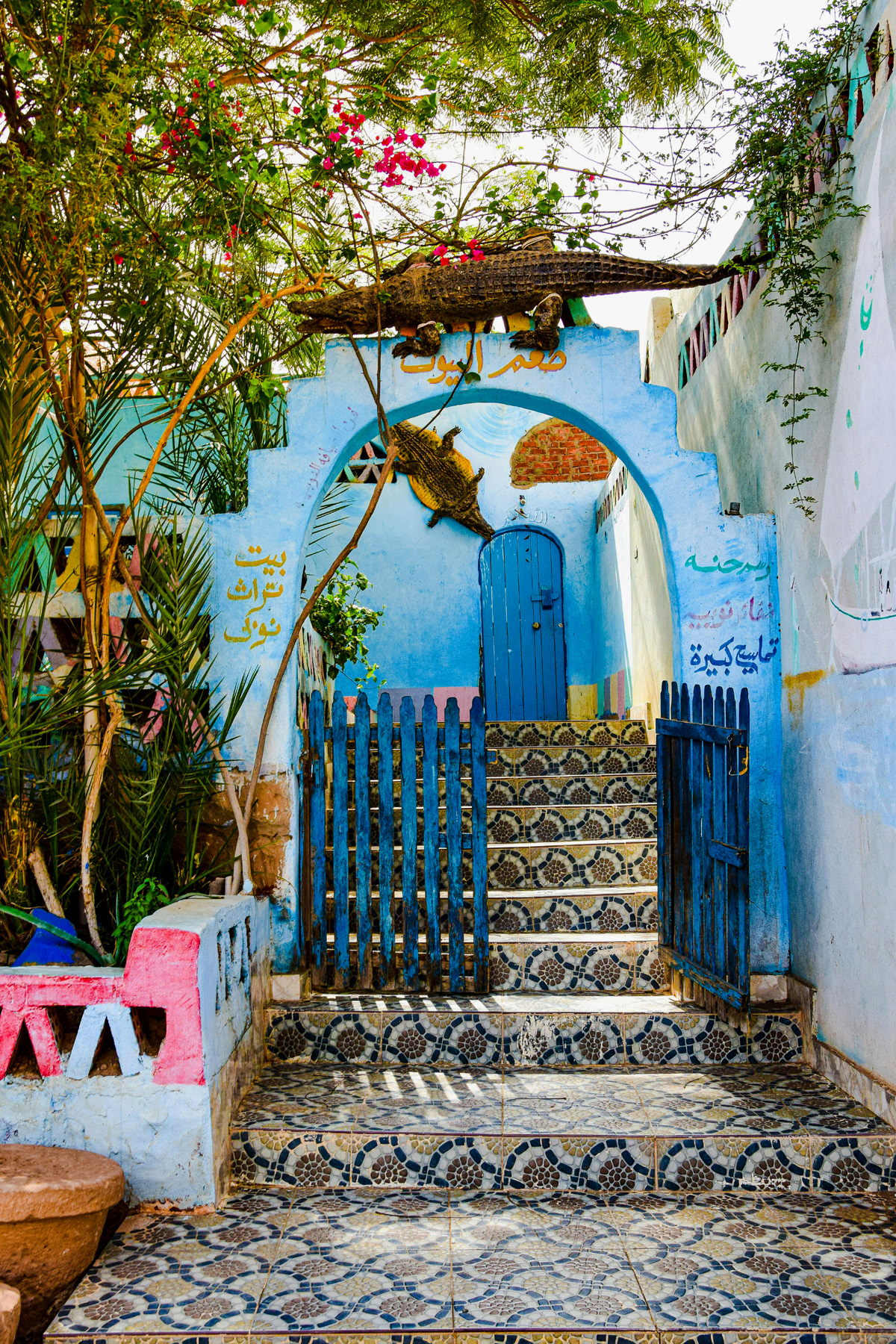

Take a felucca to Elephantine Island to explore a colorful Nubian village lined with brightly-painted homes where ancient traditions are still preserved.
Stroll through this charming village, sip mint tea on a rooftop overlooking the Nile and browse for local handicrafts, bead jewelry and woodwork. Several local homes are open to visitors and you can step inside for a drink and a chat about local life.
Though some homes have pet crocodiles on display for visitors’ amusement. The poor animals are kept inside tiny concrete cells and I’ve always avoided this activity. I definitely wouldn’t recommend it as a humane or ethical attraction.
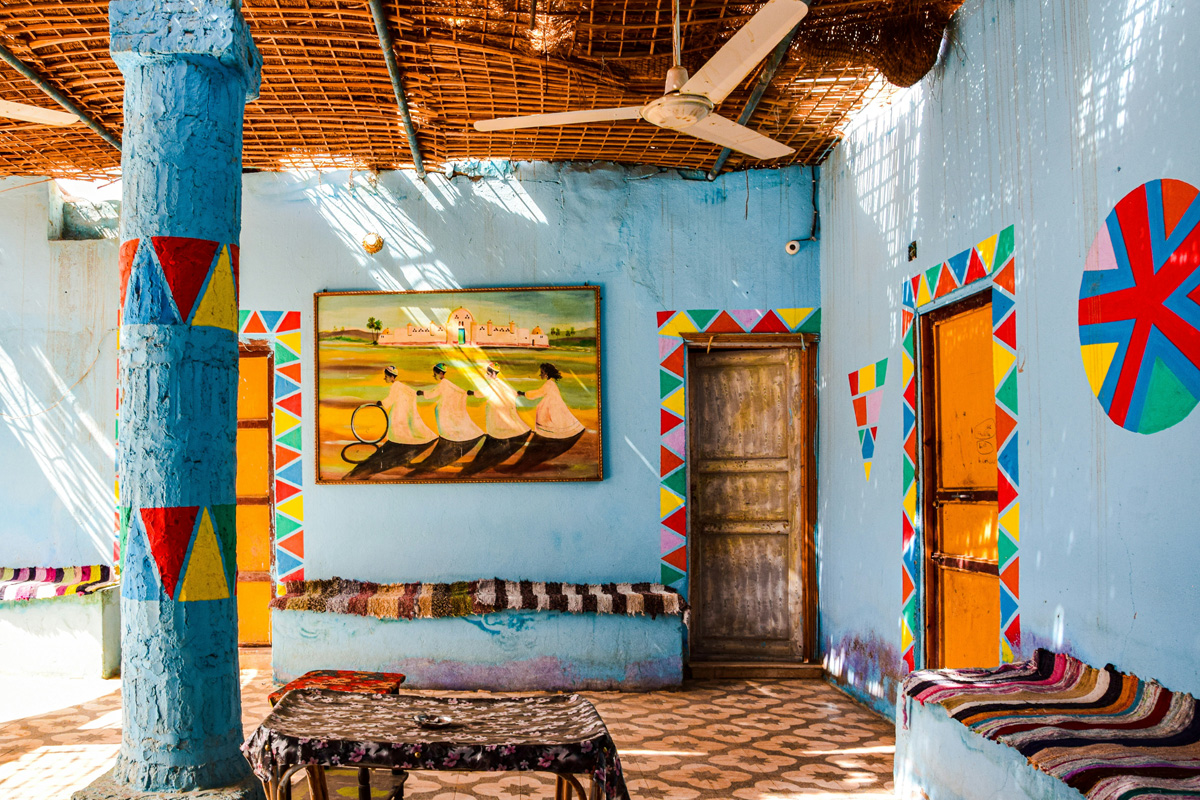

The Nubian people (an ethnic group who live in southern Egypt and northern Sudan) are some of the most cheerful and kind people you’ll meet. And though the island does get touristy, you’ll still catch a good glimpse of everyday local life. Farmers still graze their sheep and tend their fields in the village backstreets.
Nubians have their own language and culture – and they’re considered one of Africa’s oldest indigenous groups. A stroll through Elephantine Island and its lines of geometrically painted homes is a great intro to their community.
Visit Elephantine Island by local ferry from the boat landing in downtown Aswan, or hire a felucca for a more leisurely sail around the island.
7. Shop for authentic handicrafts
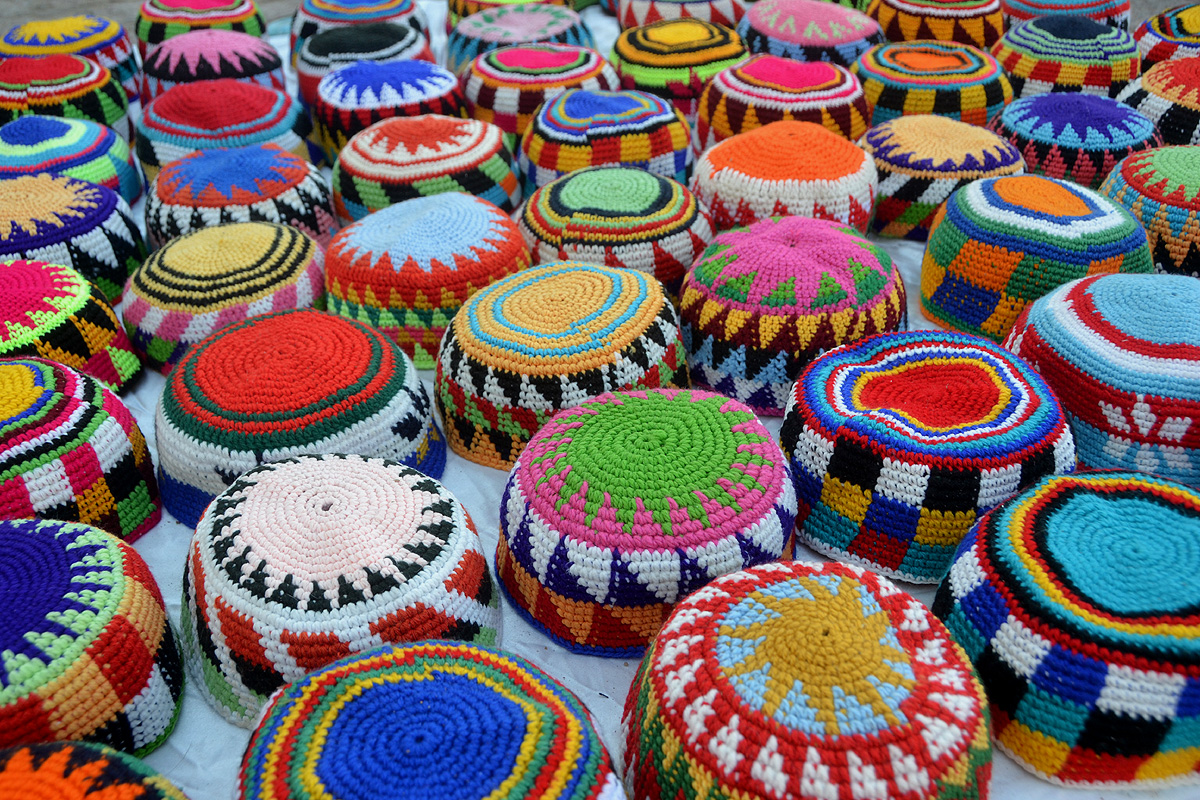

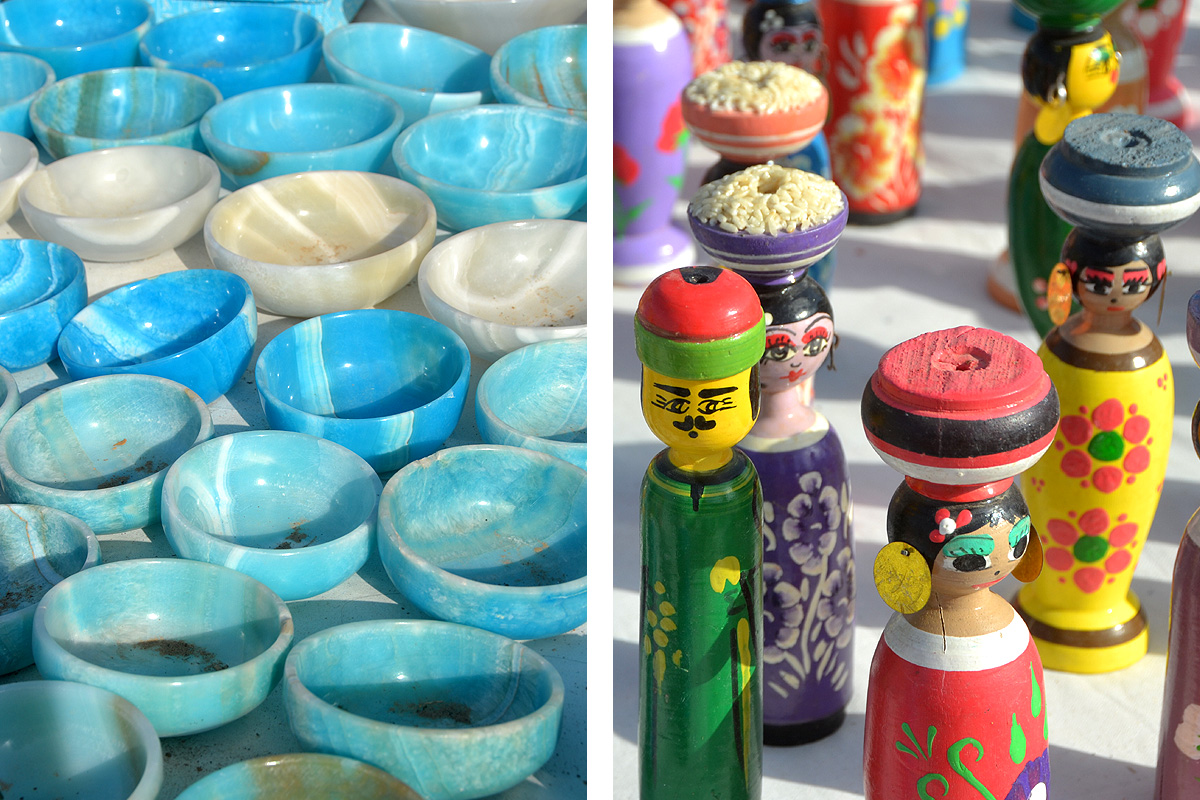

Aswan is famous for its colorful and unique handicrafts – and items you won’t find anywhere else in Egypt.
From blue alabaster bowls and beaded jewelry to wooden statuettes in local dress, Aswan has some of the most creative artisans in the country.
Start at the souq at the marina (on your way to Philae Temple) for some great finds laid out on the docks. They include piles of statement jewelry and rings, carved wooden Bastet statues and handpainted bowls.
And don’t miss Sharia el Souq, a bustling downtown market with a more laidback vibe than many of Egypt’s more hectic tourist bazaars.
Wander down the sidestreets to uncover some unusual finds like Sudanese swords, stuffed crocodiles, wooden African masks, Nubian talismans and colorful skullcaps and baskets handmade by Aswan women.
Sip on some mint tea at a street cafe and grab a bag of Aswan’s famous ful sudani, or peanuts, which are known here for their quality.
For 18-carat gold jewelry and custom cartouche necklaces, head to Hanafi Bazaar.
8. Marvel at the Unfinished Obelisk
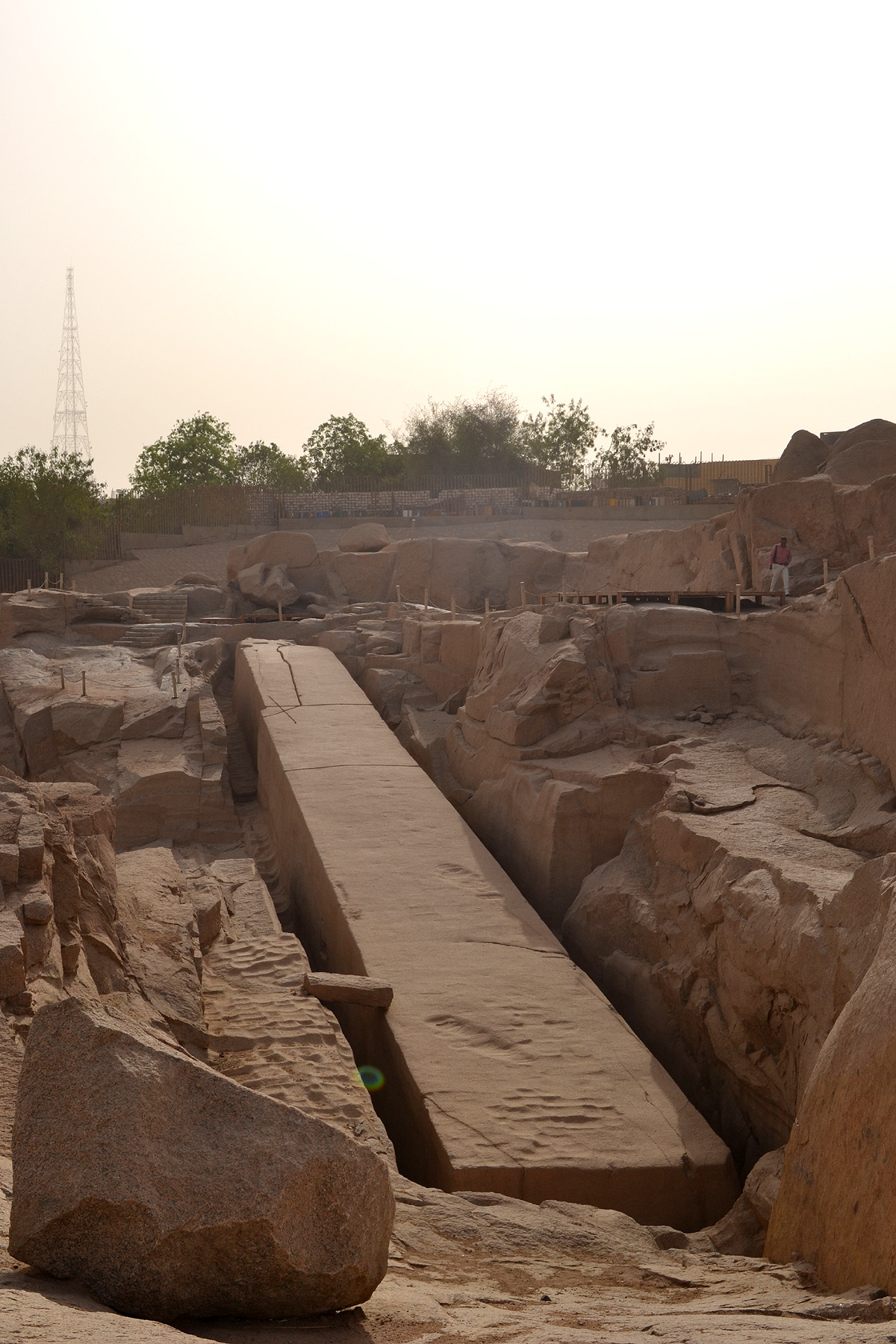

This ancient marvel would have been the world’s tallest obelisk, but it cracked during quarrying and was left abandoned and laying in the ground.
The Unfinished Obelisk was Queen Hatshepsut’s mega project – and slated to rise 42 meters high at the Karnak Temple in Luxor.
But the obelisk cracked right down the middle and the project was abandoned. Today you can see this red granite obelisk laying in stone exactly as it was left behind in the quarry thousands of years ago, still partly attached to the surrounding rock.
The Unfinished Obelisk provides valuable insights into how Ancient Egyptians shaped stone without the use of machines or modern tools.
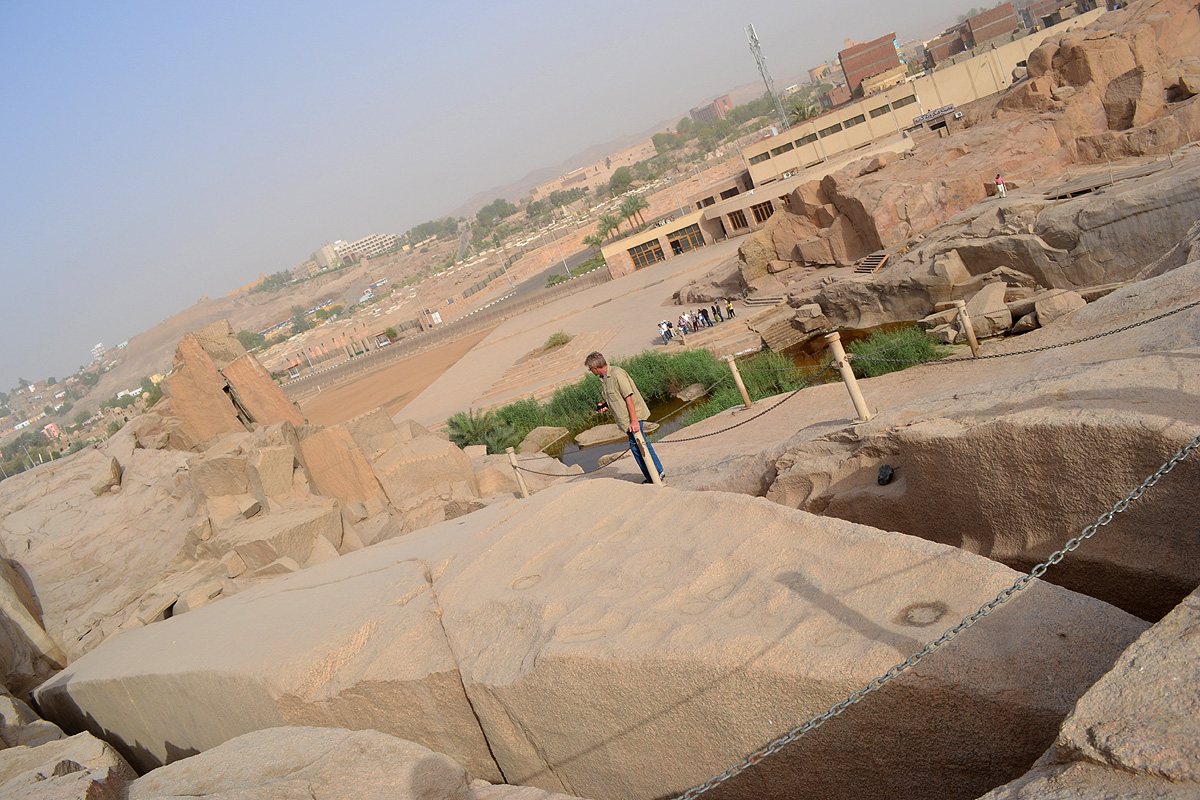

Workers would carve the obelisk right out of the bedrock and pound it into shape with stones, transforming it from a rugged block into the seamless obelisk you’ll see today in Luxor.
The obelisk was detached from the surrounding stone by boring holes along a like, and then driving wooden wedges into the holes and soaking the wedges with water until they expanded and detached from the rock.
The Unfinished Obelisk is a surreal sight and offers an appreciation for the ancient engineers who cut these massive structures and transported them to temples across Egypt.
Don’t miss the whimsical rock paintings in the pit of the obelisk left behind by the workers. They include paintings of dolphins, flamingos and ostriches.
9. Take a felucca at sunset
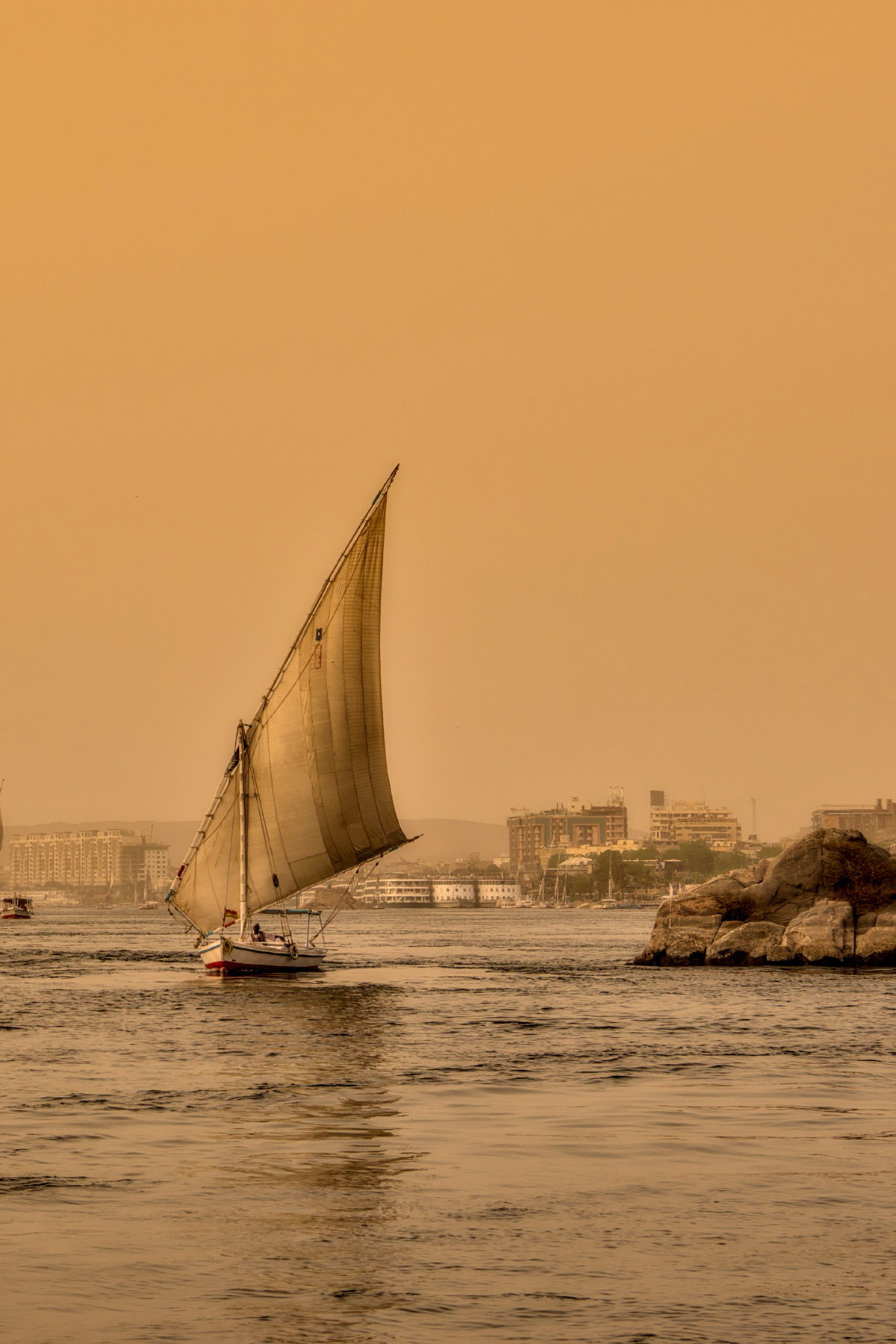

Take a sail down the Nile River in a felucca boat, the traditional wooden vessel used throughout the Mediterranean, for an unforgettable views of Aswan at sunset.
You’ll find feluccas for hire all along the corniche and no shortage of eager captains to take you for a one-hour sail. Prices are negotiable and haggling is expected – what you pay depends on your bargaining skills, the route of the felucca and the season.
If you’re with a tour guide, all arrangements and prices will be settled ahead of time.
A felucca sail is an incredible way to enjoy sweeping views of the city and catch glimpses of Nile wildlife without the noisy engines of a motorboat.
You can hire a felucca for a one-hour sunset trip, or a longer sail going around Elephantine Island and taking in its rugged vegetation.
For a real adventure, hire a half-day felucca and plan multiple stops at Aswan attractions like Kitchener’s Island and the Tombs of the Nobles along with a stop for some beach time and a swim in the Nile.
10. Have high tea at the Old Cataract
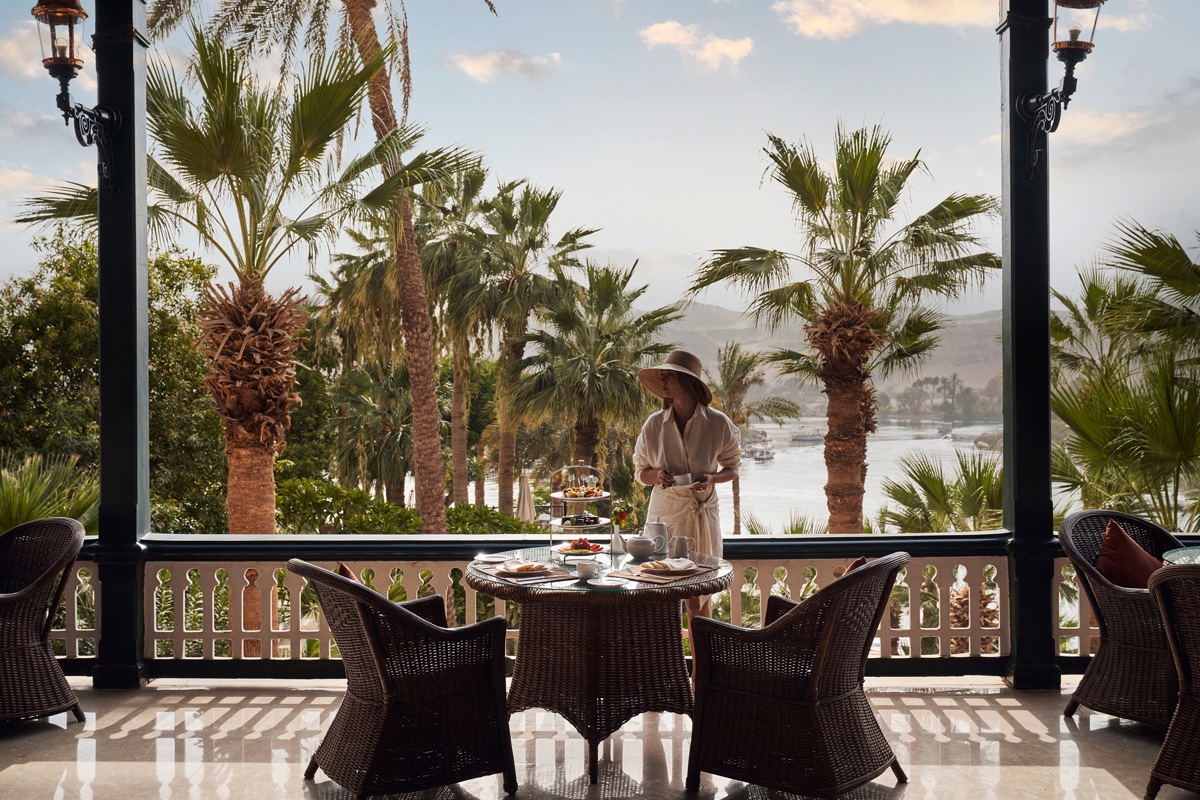

This 5-star historic resort is famous for its latice-lined terrace that overlooks the Nile and its gliding feluccas.
Built in 1899, the Sofitel Legend Old Cataract Aswan is a Victorian-style landmark in its own right with its ornate facade and manicured gardens.
Agatha Christie famously worked on parts of her novel Death on the Nile while staying in one of the Cataract’s luxurious suites in 1937.
Christie’s original desk and wicker chair where she dreamed up her intriguing plots are on display in the lobby. And there’s a free daily tour each day that lets you visit her suite.
The hotel boasts an impressive guest list that includes state dignitaries like Winston Churchill, Tsar Nicholas II and Princess Diana.
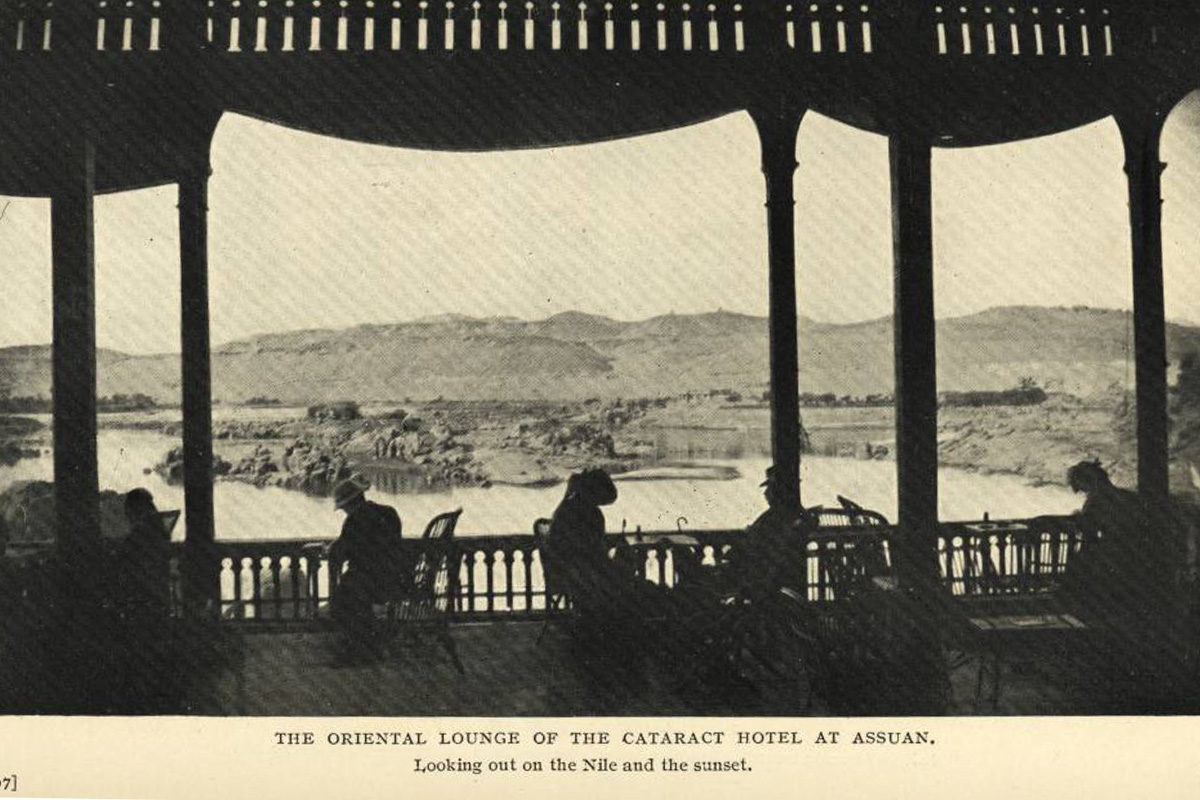

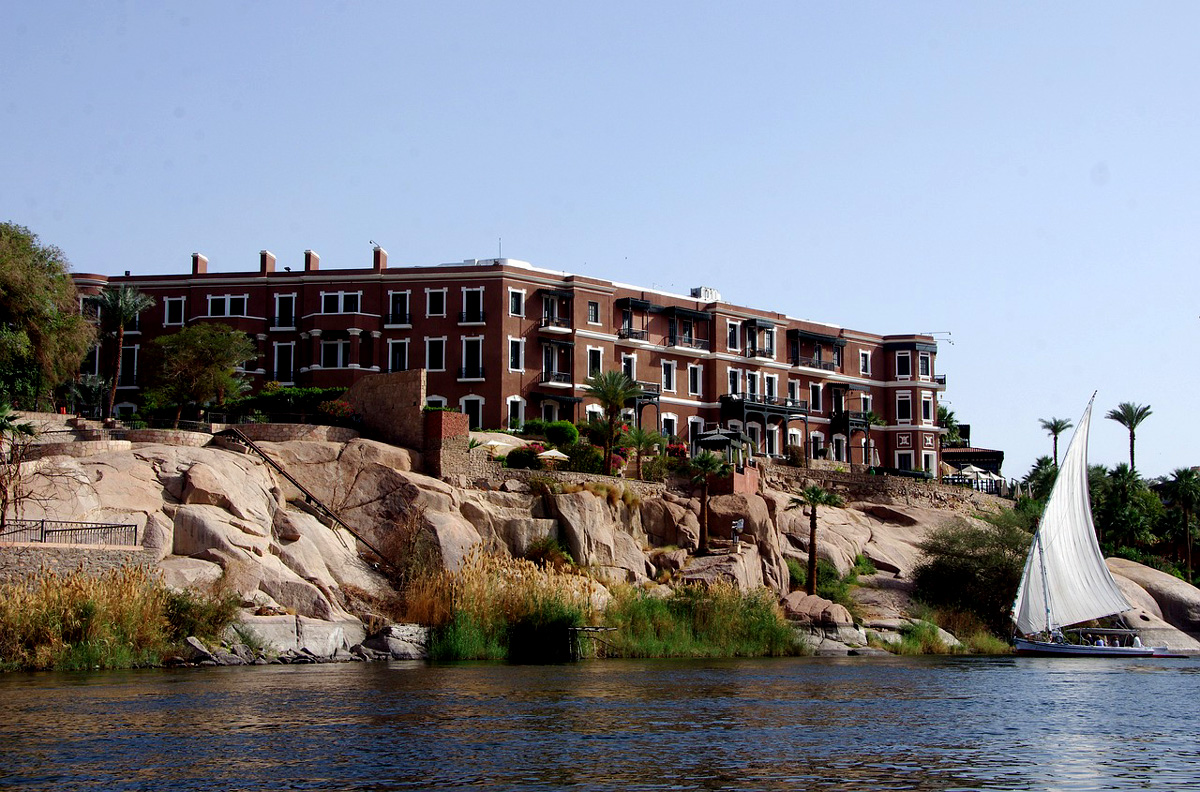

Stop by for high tea at the gorgeous Terrace Restaurant (yes it’s open to non-guests!) to take in the sweeping river views and the historic atmosphere. There’s a selection of sandwiches, scones and desserts on the menu with iconic views over the Nile and Elephantine Island.
Or head to the sumptuous 1902 Restaurant for a candlelight dinner surrounded by oriental arches and chandeliers. This restaurant was inaugurated by Winston Churchill and it’s a perfect spot for a romantic or celebratory dinner over piano music and French cuisine.
11. Visit the Aswan High Dam
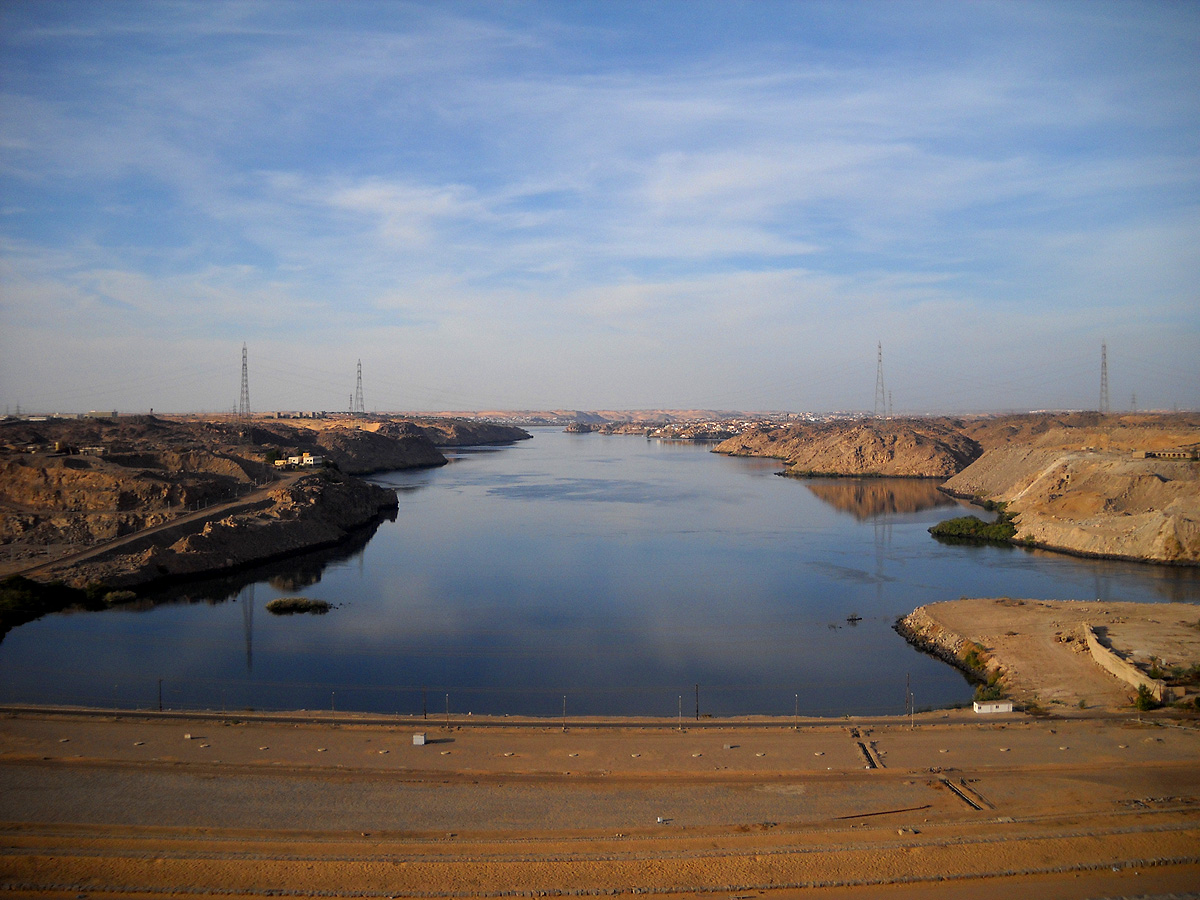

The Aswan High Dam (about a half hour from Aswan) is worth seeing for its engineering marvels and sweeping views of Lake Nasser.
Built in the 1960s to harness electricity and stop the flooding of the Nile, the Aswan High Dam also caused flooding that led to the displacement of some 90,000 Egyptians, especially Nubians.
It also submerged numerous historical monuments. Some were relocated, like Philae Temple and Abu Simbel, while others were forever lost under the water. And it also drove away the crocodiles who were common in this part of the river until the dam eliminated their ecosystem.
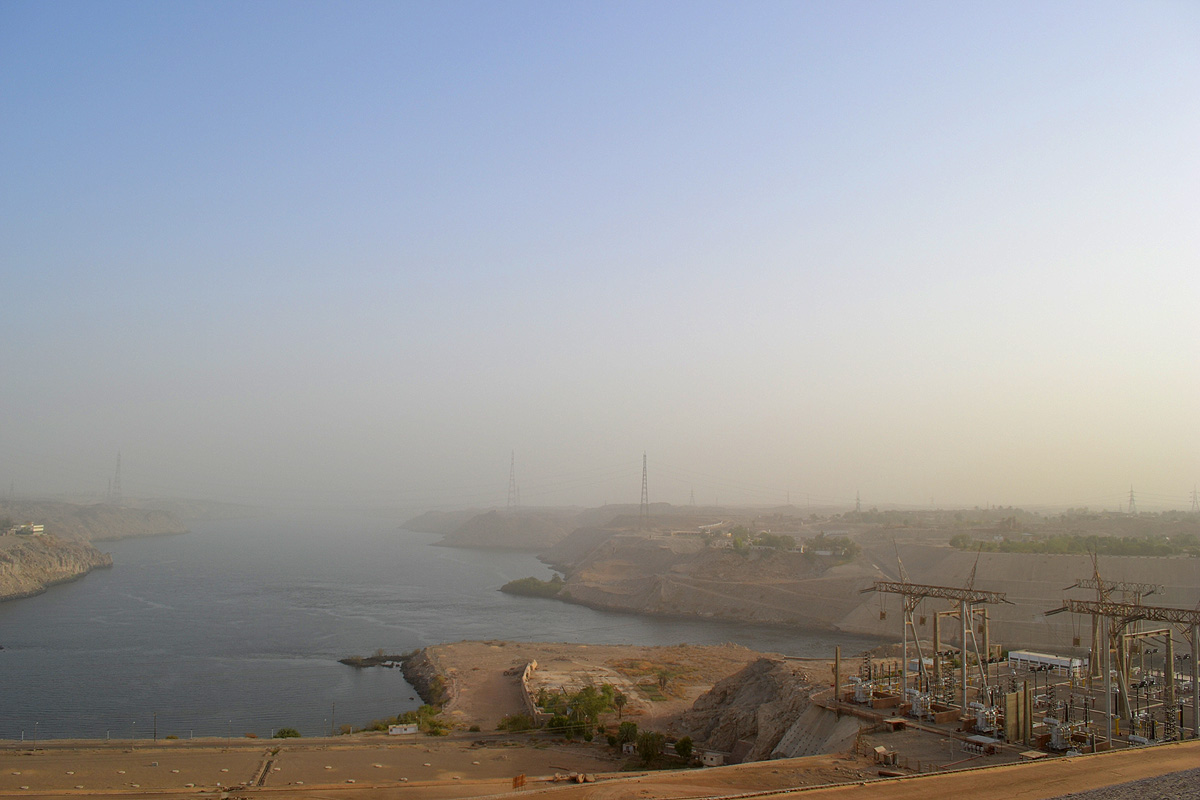

Take a walk to the dam wall and gaze over the edge at the sweeping waters of Lake Nasser, a massive reservoir that stretches some 550 kilometers in length and constituted one of the world’s largest man-made reservoirs.
And don’t miss the Lotus-shaped monument nearby that was built as a tribute to Soviet-Egyptian friendship. The Soviet Union helped to fund the dam and offered technical help during construction (the two countries had good relations under then-president Nasser).
If you’re coming from the Aswan airport into downtown Aswan, you’ll pass over the dam on your way.
12. Have dinner with a view
Perched on Elephantine Island, the Panorama Restaurant offers brilliant 360-views over Aswan. It’s especially magical at sunset when the river shimmers in golden light as feluccas glide between the islands.
The restaurant is inside the Movenpick Resort, which is the highest building in Aswan so the views are impeccable. The resort has a shuttle boat that takes a few minutes to the island from the mainland.
Panorama is one of the best restaurants in Aswan with a menu of Egyptian favorites like mezze, tagines and kebab served with cocktails and wine.
13. Take a day trip to Abu Simbel
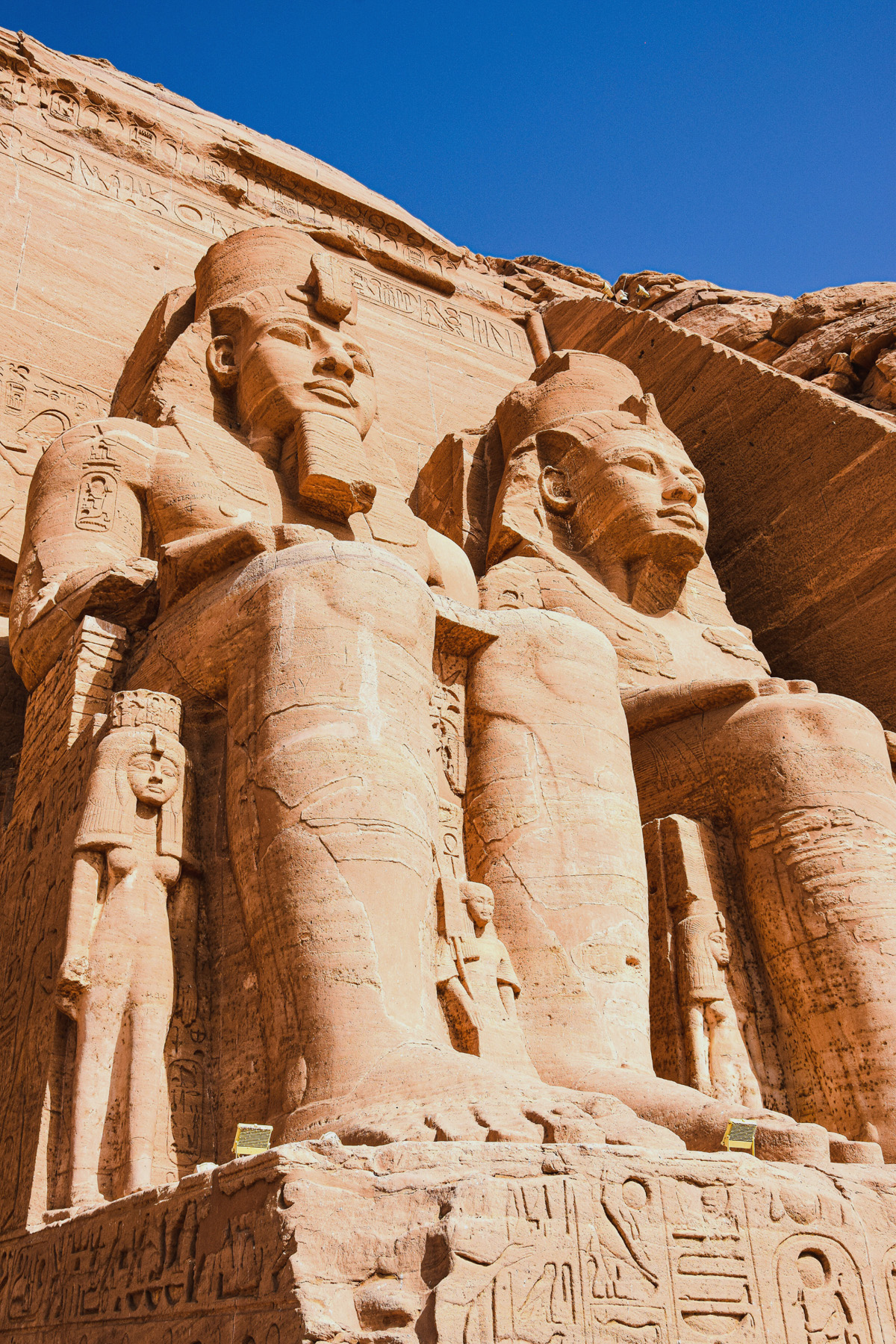

The enormous temples at Abu Simbel are one of the most breathtaking sight in all of Egypt – and they’re an easy day trip from Aswan by private car or plane.
The enormous sandstone statues of Ramses II and carved right into the mountain facade. And they’re so colossal they can be seen from the airplane (you’ll hear audible gasps on the when you’re flying into Abu Simbel and travelers get their first glimpse of these ancient wonders).
Hire a guide for the day who’ll take you from Aswan to Abu Simbel by private car. It’s about a 3-hour drive through the desert with several hours of sightseeing with an Egyptologist at the temple followed by an Egyptian lunch. You’ll be back in Aswan in time for dinner. Or take a plane to save time and land at Abu Simbel in the early morning.
Built by Ramses II, the site contains two twin temples carved out of the mountainside in the 13th century BCE.
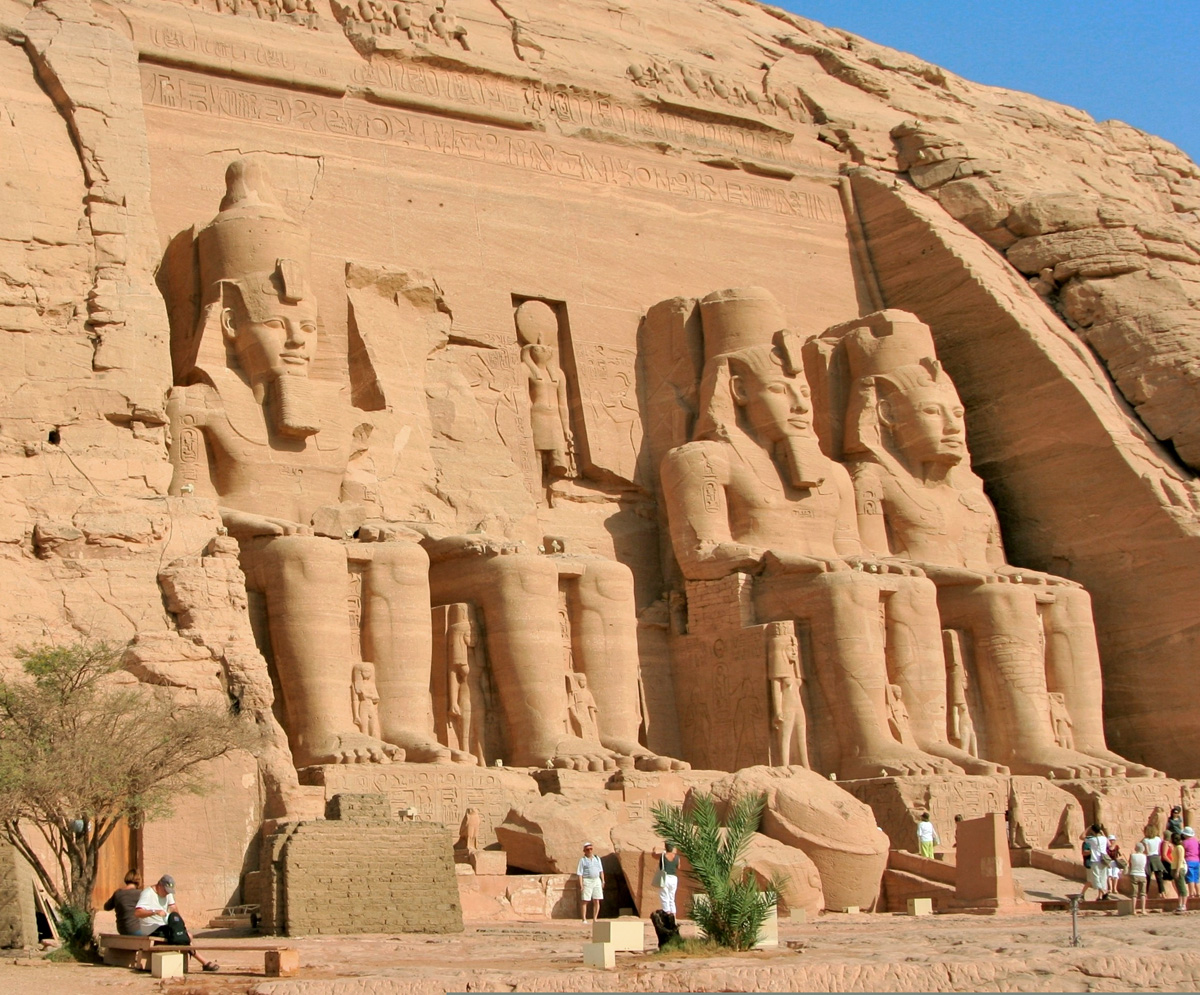

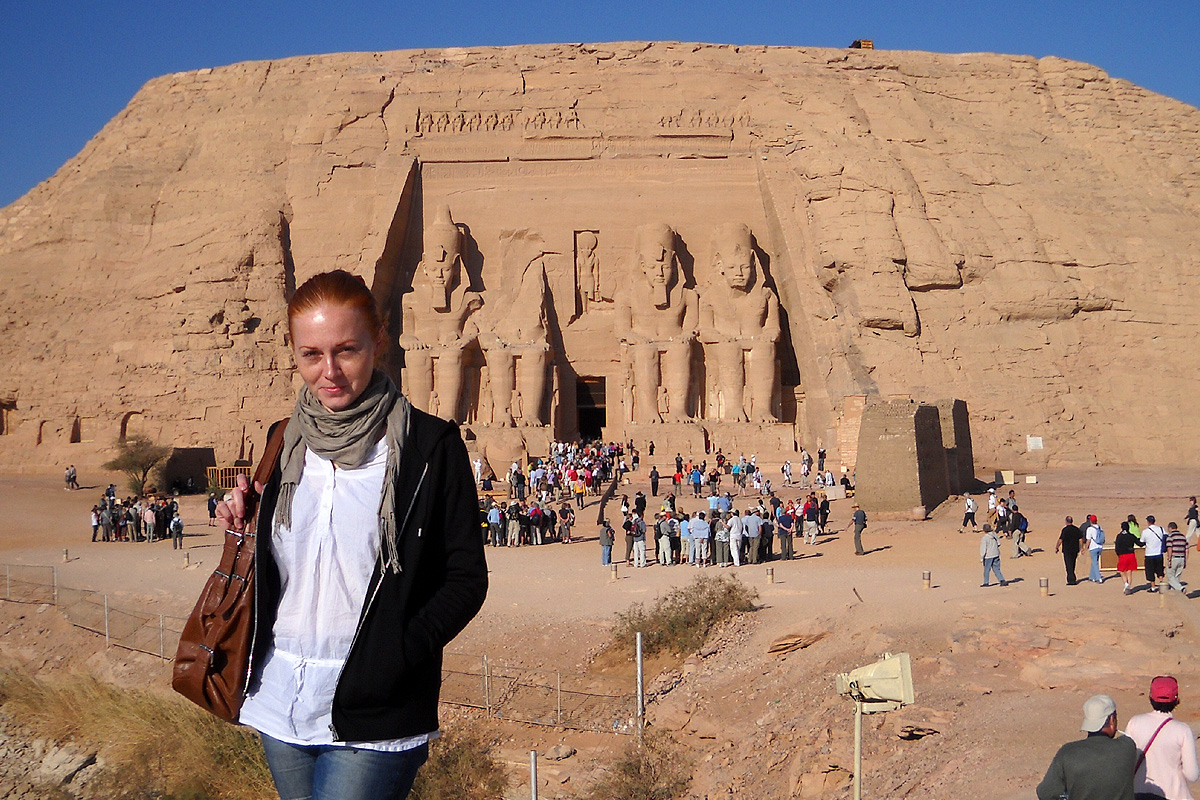

The smaller temple is dedicated to the goddess Hathor and Nefertari, Ramesses II’s chief consort. It’s one of a few in Ancient Egyptian where the statues of the king and his consort are equal in size.
Abu Simbel is well worth the trip from Aswan – and I’d definitely say it’s one of Egypt’s most breathtaking temples.
Abu Simbel also has an incredible rescue story. The temples were nearly lost in the 1960s with the construction of the Aswan High Dam and the rising Nile waters. They were entirely relocated in an epic UNESCO project in 1967.
14. Take a day trip to Kom Ombo
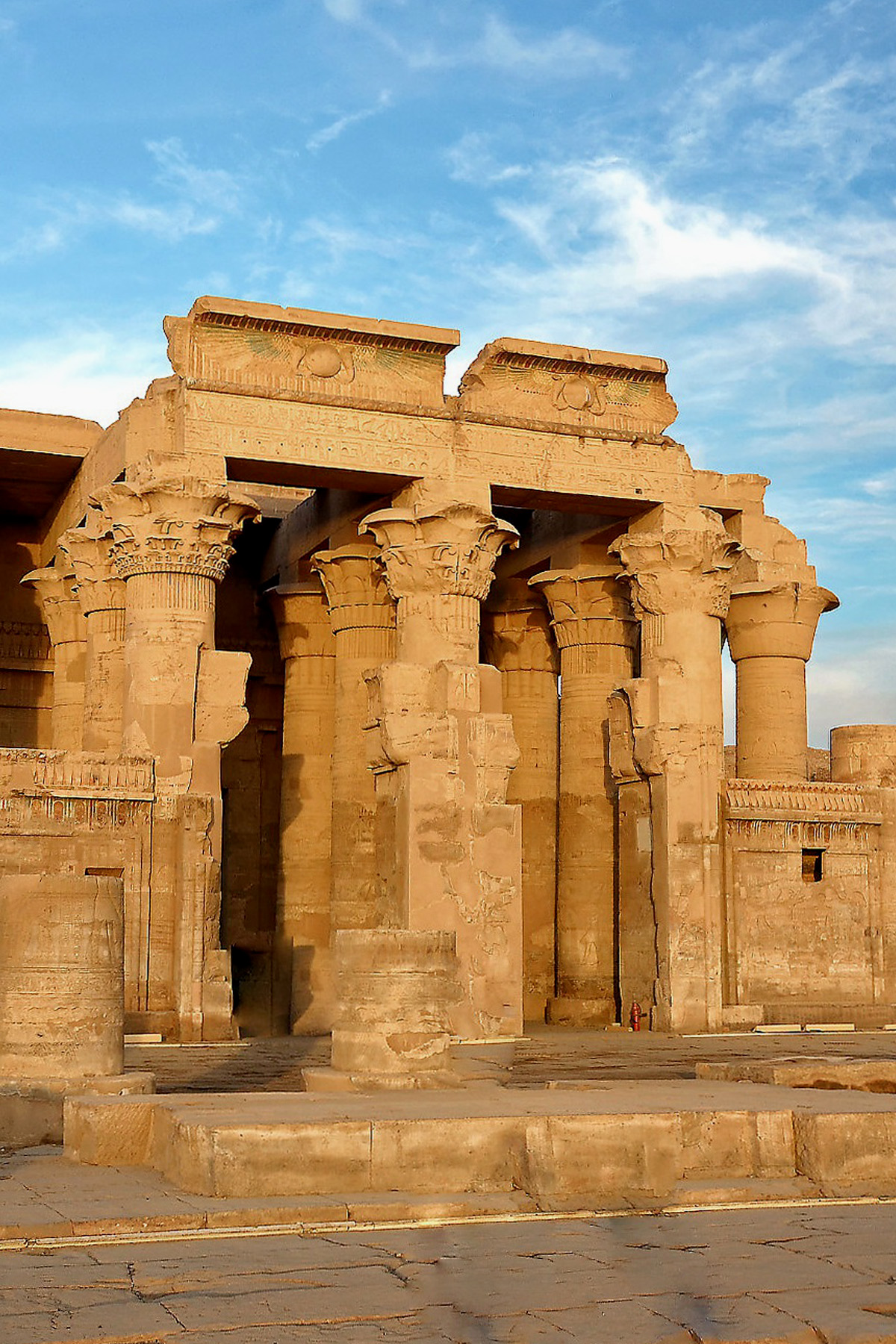

Kom Ombo is a fascinating Nile-side temple dedicated to the crocodile and falcon gods – and a perfect day trip that’s just ONE HOUR from Aswan.
Divided with perfect symmetry into two parts, the right side of the temple is dedicated to Sobek, the crocodile god of fertility and creator of the world. The left side is dedicated to Horus the Elder (aka Haroeris) the falcon god of the skies.
It’s also one of the last pagan temples built in Ancient Egypt before the Roman invasion and the spread of Christianity.
And don’t miss the Crocodile Museum next door with its vast collection of crocodile mummies.
Dimly-lit and nicely air-conditioned, the museum is a welcome respite after a hot afternoon of exploring the temple. Entrance is included in your ticket to the temple.
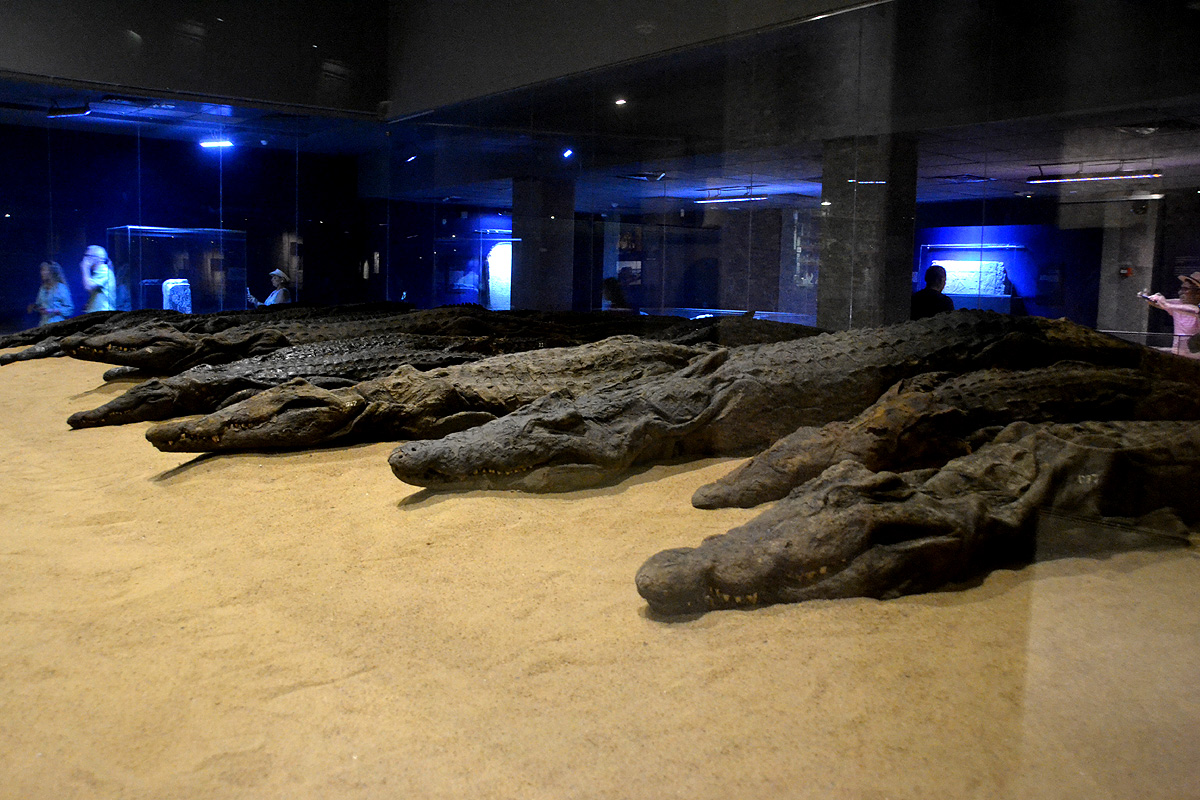

It’s estimated that some 300 crocodile mummies were discovered in this area. And many are on display at the museum basking in the sand like they did in ancient times.
You can add on a visit to Edfu (about an hour further north) to your day trip to Kom Ombo to make it an all-day excursion that typically takes about 9 hours. Edfu is a Ptolemaic-era temple that’s entirely dedicated to the falcon god Horus – and it’s another must-see on this stretch of the Nile.
If you’re planning to take a Nile cruise, then a visit to both Kom Ombo and Edfu is included on most itineraries. But if you’re not planning to cruise the Nile then a day trip is definitely worth doing if you’re interested in more Ancient Egyptian temples.
15. Embark on a Nile cruise
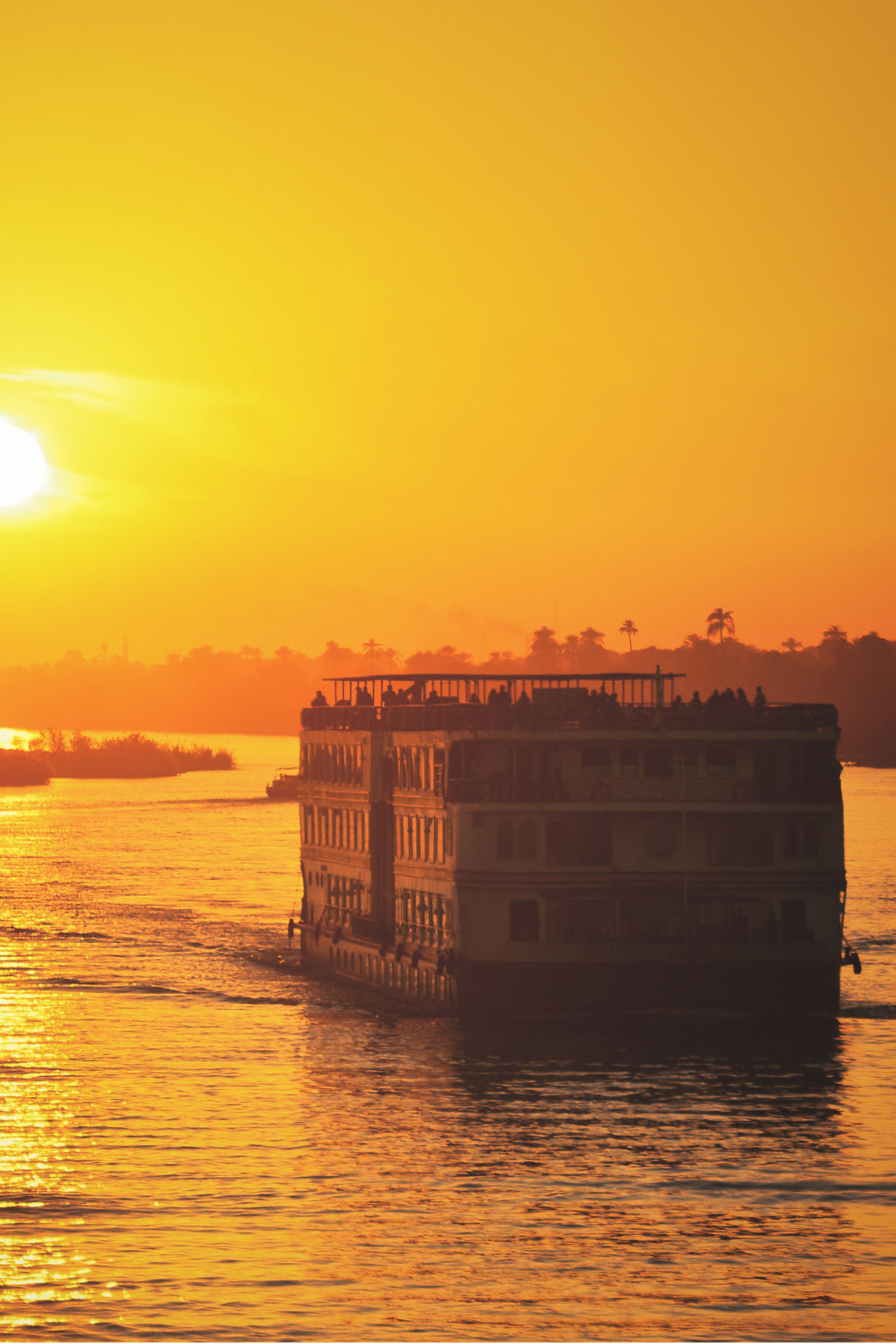

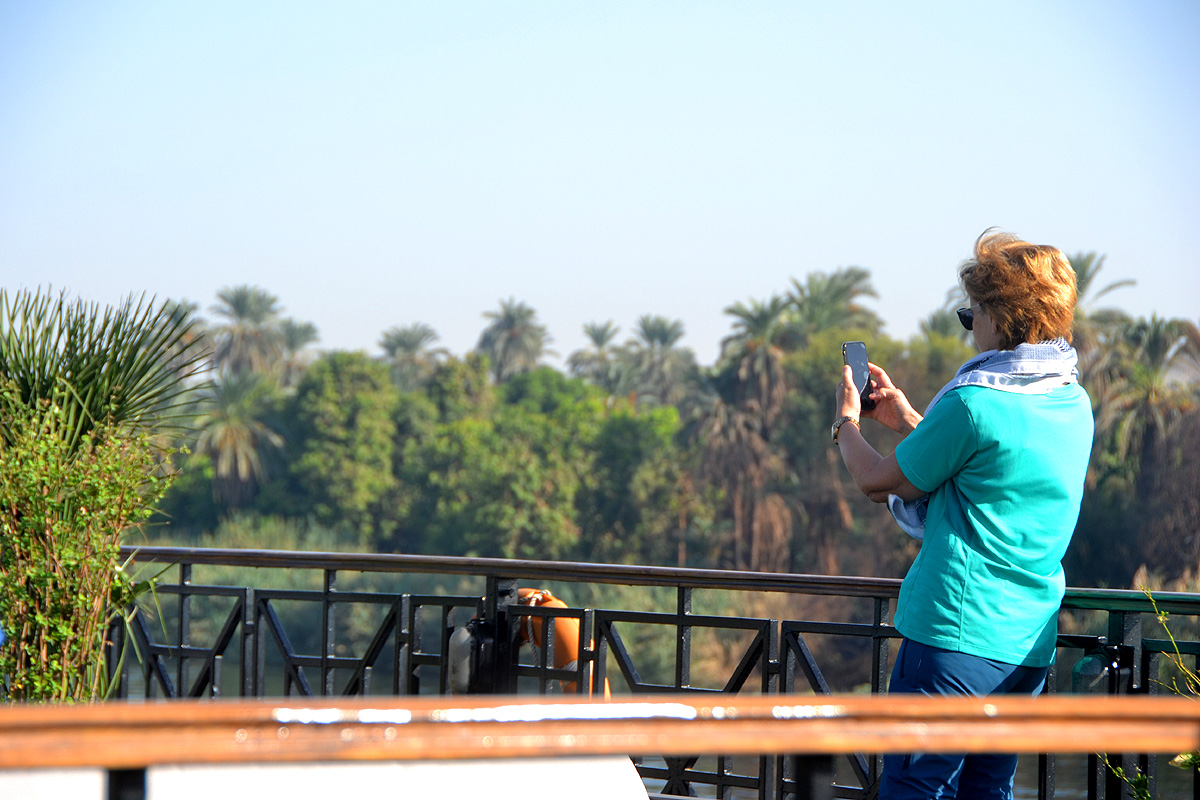

Catch a Nile cruise from Aswan for the best (and easiest) way to see Ancient Egypt’s most iconic temples – and the lush scenery along the way.
Aswan is a typical starting point for a 3 or 4-night cruise that takes you down the Nile to Luxor with stops at the majestic monuments along the way. It’s the most comfortable way to see these ancient wonders with no hurried plane and hotel transfers needed.
During the cruise from Aswan to Luxor, ships usually stop at two different temples: Kom Ombo, dedicated to the ancient crocodile and falcon gods, and Edfu, dedicated to sky god Horus.
The trip ends in Luxor where you’ll see Egypt’s most incredible temples like Karnak, Hatschepsut and Luxor Temple, plus the tombs at the Valley of the Kings.
You’ll get plenty of time to sit on the boat sundeck, sip a beer, take a swim and enjoy the scenes of rural Nile life sweeping past. But most days are filled with sightseeing with windows of downtime.
A cruise lets you avoid the logistics of inter-city travel. You don’t have to book tour guides, buses, planes and taxis because everything is included (including sightseeing and meals).
Where to eat in Aswan
Head to the stunning Panorama Restaurant on Elephantine Island for a luxurious meal with the best Nile views in town from atop Aswan’s highest building.
The beautiful Terrace Restaurant at the legendary Cataract is a beautiful spot for lunch with iconic views and a historic ambiance.
And don’t miss the offbeat and wonderful King Jamaica Restaurant, a laidback family eatery overlooking the Nile that fuses Nubian and Jamaican cuisines with local favorites. From jerk chicken to fish tagine, the food is some of the most flavorful in the city.
Where to stay in Aswan
The Sofitel Legend Old Cataract is a top choice for its incredible history, colonial architecture and the best dining in the city. Stay here to walk in Agatha Christie’s footsteps and experience a bygone era along the Nile.
The Movenpick Resort Aswan is a picturesque hotel nestled on an island with panoramic views and outstanding food. This is where I stayed during my last Nile cruise and I highly recommend it. My room was enormous with two floors of space and a sweeping terrace facing the Nile. An absolute dream!
Try the colorful Nuba Dool Guest House for a beautiful and budget-friendly stay. Perched on Elephantine Island, it boasts spotless rooms, friendly staff and wonderful terraces with Nile views.
How to get to Aswan
Fly directly from Cairo to Aswan Airport for the easiest and quickest way to travel. Both Egypt Air and Air Cairo have numerous daily flights between Cairo and Aswan. The flight is about 1 hour and 30 minutes and very affordable at US$70 on average.
There’s also a 10-14 hour overnight sleeper train from Cairo to Aswan, which offers a more adventurous and scenic way to travel. The train is comfortable but not luxurious – and it’s about US$125 per person for a single cabin, which makes it costlier than flying.
If you’re on a budget, travel to Luxor by GoBus and then switch over to train for the Luxor-Aswan stretch of the journey. Download the GoBus app to book online.
How to get around Aswan
Aswan isn’t a big city so many attractions are walkable or a short microbus away. Aswan doesn’t yet have Uber, so you’ll have to negotiate fares with taxis beforehand.
Best time to visit Aswan
Visit Aswan from October to April for mild weather and sunshine. This is the high tourist season so expect higher prices and bigger crowds.
Egyptian summers are brutal and if you’re visiting in the hot months (from May to September) then pace yourself, go sightseeing in the early mornings and pack plenty of water.
Aswan is one of the hottest and sunniest cities in the world with average high temperatures above 40 C (104 F) in the summer. It’s bright and sunny year-round so expect blue skies even on cool winter days.
How long to stay in Aswan
One day in Aswan is enough to see the major attractions including Philae Temple, the Unfinished Obelisk, the Nubian Museum and the Nubian Village. Two days is perfect to get a well-rounded look at the island and its lesser-known attractions like the botanical gardens. Three or four days is ideal for a more laidback getaway with time for half-day felucca trips and getting off the beaten path.
Aswan one-day itinerary
Head to Philae Temple in the early morning to explore the temple and avoid the crowds. Next, explore the Unfinished Obelisk and make a stop at the Nubian Museum.
Indulge in a late lunch at the Old Cataract Hotel and then take a felucca to the Nubian Village before sunset for a walk through the Nubian homes and handcraft stalls.
Conclusion
I would love to hear from you. Do you have any questions about visiting Aswan? Let me know in the comments!
MORE RESOURCES:
Pin it:


